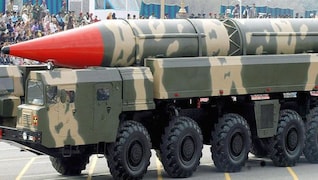Pakistan expanding its nuclear arsenal, may have ‘200 warheads’ by 2025: US report
The ‘Bulletin Of The Atomic Scientists’ report said that the country currently has approximately 165 warheads and is looking to expand with more warheads, more delivery systems, and a growing fissile materials production industry
Pakistani spectators watch the Shaheen-II long range missile capable of carrying a nuclear warhead on its launcher. AFP
The ‘Bulletin Of The Atomic Scientists’ report said that the country currently has approximately 165 warheads and is looking to expand with more warheads, more delivery systems, and a growing fissile materials production industry
In news that should worry India, Pakistan continues to expand its nuclear arsenal with more warheads, more delivery systems, and a growing fissile materials production industry, according to a report in the US-based ‘Bulletin Of The Atomic Scientists‘ dated 9 September.
According to the publication, if the country continues in the same manner, it will have 200 warheads by 2025. “We estimate that the country’s stockpile could more realistically grow to around 200 warheads by 2025 if the current trend continues,” read the report prepared by Hans M Kristensen, director of the Nuclear Information Project at the Federation of American Scientists, and Matt Korda, research associate for the NIP.
It added that Pakistan as of date has a nuclear weapons stockpile of approximately 165 warheads. However, the Pakistani government has never publicly disclosed the size of its arsenal and media sources frequently embellish news stories about nuclear weapons.
Pakistan’s nuclear stance
Pakistan is pursuing what it calls a “full spectrum deterrence posture,” which includes long-range missiles and aircraft for strategic missions, as well as several short-range, lower-yield nuclear-capable weapon systems in order to counter military threats below the strategic level.
According to former Pakistani officials, this posture – and its particular emphasis on non-strategic nuclear weapons – is specifically intended as a reaction to India’s perceived “Cold Start” doctrine.
This alleged doctrine revolves around India maintaining the capability to launch large-scale conventional strikes or incursions against Pakistani territory below the threshold at which Pakistan would retaliate with nuclear weapons.
Pakistan’s nuclear arsenal
Pakistan has been trying to develop new short-range tactical weapons, sea-based cruise missiles, air-launched cruise missiles, and longer-range ballistic missiles for some time now. It has at least six operational nuclear-capable land-based ballistic missiles, including the short-range (60-70 km) NASR (Hatf-9) solid-fuel missile.
The medium-range missiles include Shaheen-II and newer Shaheen-III missiles. Once fully operational, researchers point out that the Shaheen-III missiles, with a projected range of 2,750 km, would bring Israel within range of Pakistani nuclear missiles for the first time. For this, these missiles will have to be deployed in the western parts of Balochistan province.
The paper further pointed out that Pakistan is also developing a multiple independent reentry vehicle (MIRV) technology-enabled nuclear-capable ballistic missile Ababeel.
Pakistan Air Force’s (PAF) Mirage III and Mirage V fighter squadrons are likely to have nuclear delivery capabilities as well. Masroor Air Base near Karachi housing three Mirage squadrons has a “possible nuclear weapons storage site” nearby that, according to the authors, has been witnessing continuous underground constructions and expansions. “This includes a possible alert hangar with underground weapons-handling capability,” said the publication.
Moreover, Pakistan has a well-established and diverse fissile material production complex that is expanding. It includes the Kahuta uranium enrichment plant east of Islamabad, which appears to nearing completion, as well as the enrichment plant at Gadwal to the north of Islamabad.
The New Labs Reprocessing Plant at Nilore, east of Islamabad, which reprocesses spent fuel and extracts plutonium, has been expanded. Meanwhile, a second reprocessing plant located at Chashma in the northwestern part of Punjab province may have been completed and become operational by 2015.
According to the report, the National Defence Complex in the Kala Chitta Dahr mountain range is ground zero to produce nuclear-capable missiles and launchers. Researchers suspect that the Pakistan Ordnance factories near Wah could be linked to nuclear warhead production.
According to the International Panel on Fissile Materials, Pakistan had approximately 3,900 kg of weapon-grade highly enriched uranium and about 410 kg of weapon-grade plutonium in early 2020. But the authors of the nuclear notebook argue that calculating stockpile size solely based on fissile material inventory could be a wrong approach.
Inputs from agencies

No comments:
Post a Comment